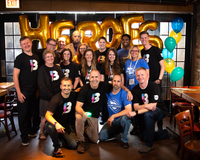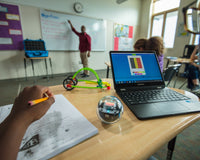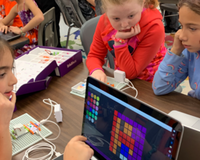In today’s digital world, learning to code and being familiar with coding concepts are a crucial part of a child’s education. In addition to the practical applications for coding, it also provides a framework for kids to become familiar with using technology, solving problems, and applying critical thinking skills from an early age.
But the question remains: when is the right time to introduce coding in a child’s education? The answer is: the earlier the better, as there are many opportunities for integrating coding at all ages. It goes without saying that five-year-olds shouldn’t be expected to understand Python, but as we’ll see there are age-appropriate activities that can introduce kids as young as four to coding concepts.
Nate Ubowski, former educator and Sphero’s Educational Product Manager, believes in the importance of teaching coding from an early age. He explains, “In our modern times, technological literacy is a driving force in helping kids be prepared for their futures. We don’t know what technological advancements will be present, but we can prepare kids to be able to adapt and solve problems that are prevalent in a technological world.”
As Nate suggests, coding is quickly becoming a central element of core education. Many educators and experts now consider programming skills to be as essential as literacy.
Nate agrees, saying, “Computer science and coding are becoming basic elements of core education. Just like we want all kids to experience and learn Science, History, Math, and Language Arts even though they won’t all have careers in those fields, we should give kids the same exposure to programming and computer science.”
In this article, we’ll be looking at how to introduce students to coding concepts from a young age as well as how to build on these concepts and establish foundational programming knowledge as they grow up.
Early Exposure to Coding Concepts and STEM (Early Education - Ages 4-7)
The aim of introducing coding at this early stage in a child’s education is to familiarize them with concepts and processes that are inherent in coding, like conditions (if/then) and sequencing (step by step). At this age, kids are continually learning about the world around them through conversations, hands-on activities, games, and new experiences. However, they are still developing their ability to focus and deeply engage with things, which is an important thing to remember when planning coding or coding-inspired activities for this age group.
In other words: any introductory coding learning should be both engaging and fun in early education. Think of games like Simon Says, which offer an unplugged entry into sequencing fundamentals. In Simon Says, players need to follow instructions exactly as givento win. Similarly, a computer program follows the commands it receives. If a programmer doesn't give it instructions, the computer won’t understand how to complete an action.
Sphero indi is another effective tool for introducing coding in early education. The small robot can be programmed in a couple of dynamic ways: first by using simple color-coded cards that can be arranged to create a path for the robot. For a slightly greater challenge, the Sphero Edu Jr app brings in basic drag-and-drop block coding. Through the app, young students can reprogram indi’s responses to the different color cards, giving them experience with foundational computer science concepts like decomposition, pattern recognition, and algorithms.

Building a Foundation in Coding Education (Middle School - Ages 8-12)
In middle school, students are not only acquiring new knowledge, they are also developing stronger logic and reasoning. Coding activities at this age should therefore build on their existing knowledge of coding principles like sequencing and pattern recognition by introducing more creativity and problem solving.
Block-based coding languages are a great place to start. This category of coding language is much more accessible than text-based programming languages and enables students to build programs using intuitive drag-and-drop blocks. For example, students can gain experience with block coding using the Sphero Edu app, which connects with our robotic products like the Sphero BOLT and Sphero Mini.
A good block-coding activity to start with is The Backpack Weave, which invites students to create an obstacle course in the classroom using backpacks and then programming the Sphero Mini to navigate the path without getting blocked. This problem-solving activity is a great way to familiarize students with block coding and command inputs, like roll, stop, and turn, as well as the speed and duration of a roll. This activity and others like it allow students to explore a variety of solutions and gives them the creative freedom to make mistakes, try again, and ultimately solve the problem, all while absorbing coding fundamentals.

Learning Complex Coding Concepts and STEM Applications (Middle and High School - Ages 13+)
With the basic principles of coding (i.e. sequencing and creating step-by-step instructions) in their skill set, older middle school and high school students can begin the transition from block-based coding to text-based coding. Text coding languages like Python and JavaScript are more complex than block coding but come with many new possibilities and can be applied in a range of real-world projects and careers, such as game and app development and web design.
Students ages 13+ can learn text-based programming languages in a practical way using the four-wheeled Sphero RVR+. For example, Sphero’s “Engineer an Apple Picker” activity gets students to combine JavaScript programming (via the Sphero Edu text canvas) with the physical creation of an apple picking mechanism that can be attached to the robot. The aim of the activity is to both design the mechanism using knowledge of simple machines, and program the apple-picking robot to collect and deliver apples for packaging. For even more advanced activities as students progress in their learning, the RVR+ robot can be used with third-party hardware like Raspberry Pi.

The Time to Code is Now
Ultimately, integrating coding into education from an early age is not just a good idea, it’s essential to prepare the next generation for their future careers. Understanding coding and coding principles, like algorithms, demystifies how all technology works and equips young learners with the skills and creativity they need to tackle problems in not only computer sciences but all STEM subjects.
For more resources on coding education for kids of different ages, Sphero has many resources available, such as the Sphero Edu app and programmable robots like the Sphero indi and BOLT. In our experience, the integration of hands-on robots in coding education has proven to be highly popular amongst students, allowing for a balance of structured learning and fun.
About the Author
The Sphero Team

The Sphero Team is comprised of current and former educators, education content and curriculum writers, product designers, engineers, executive leadership, and other experts in their fields. Learn more about who we are and what we do at sphero.com/about.










